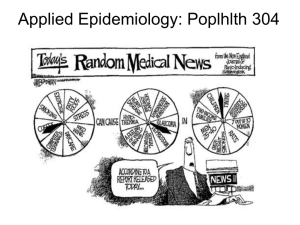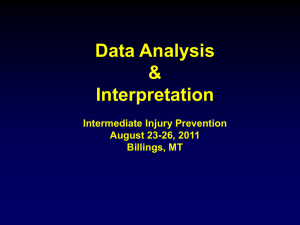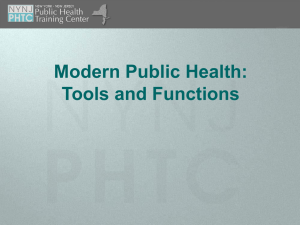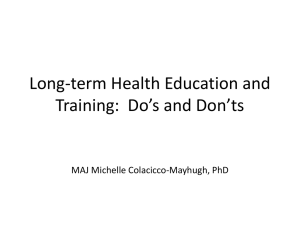chapter 7 slides
advertisement
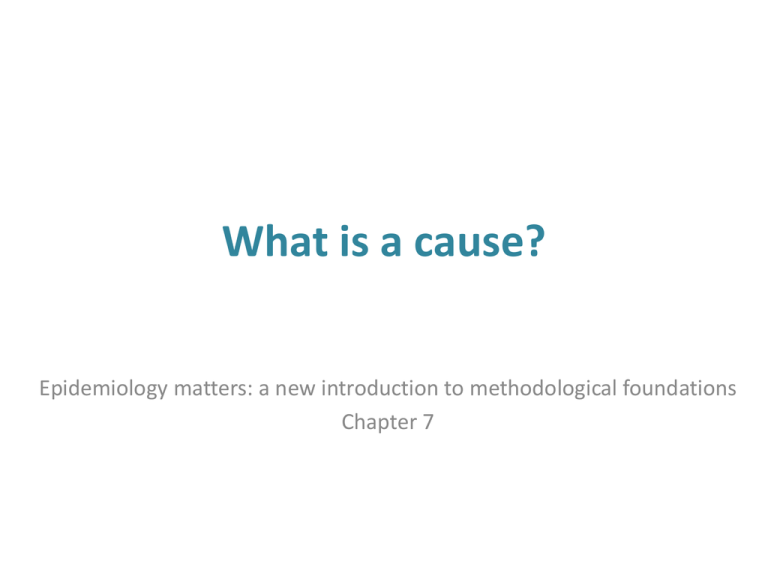
What is a cause? Epidemiology matters: a new introduction to methodological foundations Chapter 7 Seven steps 1. Define the population of interest 2. Conceptualize and create measures of exposures and health indicators 3. Take a sample of the population 4. Estimate measures of association between exposures and health indicators of interest 5. Rigorously evaluate whether the association observed suggests a causal association 6. Assess the evidence for causes working together 7. Assess the extent to which the result matters, is externally valid, to other populations Epidemiology Matters – Chapter 1 2 Early conceptions of cause “for now, I will stretch out mine hand, that I may smite thee and thy people with pestilence” God, from Exodus (9:14) Epidemiology matters – Chapter 7 3 1. A motivating example 2. What is a cause? 3. Disease causation – marble game 4. Disease causation – time and space 5. Public health implications 6. Disease causation in a non-deterministic world 7. Epidemiology and probability 8. Summary Epidemiology matters – Chapter 7 4 1. A motivating example 2. What is a cause? 3. Disease causation – marble game 4. Disease causation – time and space 5. Public health implications 6. Disease causation in a non-deterministic world 7. Epidemiology and probability 8. Summary Epidemiology matters – Chapter 7 5 Motivating examples The Uncle Joe example “My mother smoked in pregnancy - no one knew the health dangers back then - and I’m just fine. All of these warnings about smoking during pregnancy are overdone.” If one person smoked in pregnancy with no adverse consequences for their offspring, can we conclude that smoking in pregnancy is not harmful? Epidemiology matters – Chapter 7 6 Epidemiology matters – Chapter 7 7 Unexposed Exposed Epidemiology matters – Chapter 7 8 Unexposed Exposed Unexposed with disease Epidemiology matters – Chapter 7 Exposed with disease 9 Epidemiologists understand disease causation to be a multifactorial process Epidemiology matters – Chapter 7 10 1. A motivating example 2. What is a cause? 3. Disease causation – marble game 4. Disease causation – time and space 5. Public health implications 6. Disease causation in a non-deterministic world 7. Epidemiology and probability 8. Summary Epidemiology matters – Chapter 7 11 Example: A man’s depression Man developed depression Personal history: Born Boise, Idaho 1965 Parents working class Youngest of 5 children Trouble with the law growing up Married at 25, divorced 4 years ago Lost job 2 years ago What are the causes of the man’s depression? Epidemiology matters – Chapter 7 12 Would the depression have occurred if we kept everything about his life the same, but changed one detail? 1. If everything about the man stayed the same, but the plant had not closed, would the depression have occurred? 2. If everything about the man had stayed the same, but the divorce had not occurred, would the depression have occurred? 3. If everything about the man had stayed the same, but his parents had more resources in his childhood, would the depression have occurred? Epidemiology matters – Chapter 7 13 Counterfactual The counterfactual is the condition that is counter to the fact A factor is a cause if the outcome would not have occurred in the absence of that factor, holding all other things constant, including space and time. Epidemiology matters – Chapter 7 14 What is a cause? 1. A motivating example 2. What is a cause? 3. Disease causation – marble game 4. Disease causation – time and space 5. Public health implications 6. Disease causation in a non-deterministic world 7. Epidemiology and probability Epidemiology matters – Chapter 7 15 Non-diseased Epidemiology matters – Chapter 7 Diseased 16 Example: Individual diabetes Combination of causes in individuals Person 1. Obese weight, lack of preventive care, diabetes family history, 20 pack-years smoking Person 2. Poor nutritional education, diabetes family history, high blood pressure, advanced age Person 3. Obese weight, diabetes family history, high blood pressure Epidemiology matters – Chapter 7 17 Example: Individual diabetes Is each factor necessary? Is each factor sufficient? For each individual case, all component causes are necessary for that individual, but none are sufficient. Epidemiology matters – Chapter 7 18 Causes and the individual marble game Each marble is a component cause But, one marble is rarely sufficient to cause disease A particular marble set can be a sufficient cause for disease There can be more than one marble set that become a sufficient cause Causes are rooted in a counterfactual definition, each marble is a necessary cause of disease for that particular sufficient cause set Epidemiology matters – Chapter 7 19 Necessary and sufficient causes for populations Necessary if all cases of disease require the cause in order for disease to onset Sufficient if all individuals exposed to the cause will acquire the disease Causes can be necessary and sufficient unnecessary but sufficient necessary but insufficient unnecessary and insufficient Epidemiology matters – Chapter 7 20 Necessary and sufficient causes Trisomy 21 and Down Syndrome All individuals with three copies of the 21st chromosome will evidence Down Syndrome. Trisomy 21 is thus sufficient for DS. All individuals with Down syndrome have three copies of the 21st chromosome. Trisomy 21 is thus necessary for DS. Epidemiology matters – Chapter 7 21 Necessary but insufficient causes Alcohol consumption and alcoholism Not all individuals who consume alcohol will develop alcoholism. Alcohol consumption is thus insufficient for alcoholism. However, all individuals with alcoholism will have consumed alcohol. Alcohol consumption is thus necessary for alcoholism. Epidemiology matters – Chapter 7 22 Unnecessary but sufficient cause Hysterectomy and pregnancy prevention All women who have a hysterectomy are unable to become pregnant. Hysterectomy is thus sufficient for pregnancy prevention. Not all pregnancies are prevented through hysterectomy. Hysterectomy is thus unnecessary for pregnancy prevention. Epidemiology matters – Chapter 7 23 Unnecessary and insufficient cause Smoking and lung cancer Not all individuals who smoke will develop lung cancer. Smoking is thus insufficient to cause lung cancer. Not all lung cancer cases are smokers. Smoking is thus unnecessary to cause lung cancer. Epidemiology matters – Chapter 7 24 1. A motivating example 2. What is a cause? 3. Disease causation – marble game 4. Disease causation – time and space 5. Public health implications 6. Disease causation in a non-deterministic world 7. Epidemiology and probability 8. Summary Epidemiology matters – Chapter 7 25 Collecting marbles across the life course People can accumulate marbles At birth In adolescence During young adulthood At older adulthood At one point vs. slow accumulation over time Epidemiology matters – Chapter 7 26 Collecting marbles across the life course: Example Infancy Collecting throughout life tobacco smoke in utero Childhood chronic poverty, chaotic home environment in childhood Adolescence cigarette smoking starts in adolescence Adulthood ] poor nutrition in adulthood Epidemiology matters – Chapter 7 27 Marbles are not independent Shared across individuals One person’s marble collection may influence another person’s marble collection Example, person-to-person infectious disease transmission Epidemiology matters – Chapter 7 28 Examples of shared marbles Unhealthy food environment Community violence Social norms around substance use and cigarette smoking; e.g., adolescents are more likely to begin smoking if an influential peer begins smoking Policies and laws managing access to quality health care Epidemiology matters – Chapter 7 29 Sharing marble exposures Person 2 Person 1 Person 3 Person 4 Epidemiology matters – Chapter 7 30 Sharing marble exposures Person 2 Person 1 Person 3 Person 4 Epidemiology matters – Chapter 7 31 Sharing marble exposures Person 2 Person 1 Person 3 Person 4 Epidemiology matters – Chapter 7 32 Sharing marble exposures Person 2 Person 1 Person 3 Person 4 Epidemiology matters – Chapter 7 33 Sharing marble exposures Person 2 Person 1 Person 3 Person 4 34 Epidemiology matters – Chapter 7 Sharing marble exposures Person 2 Person 1 Person 3 Person 4 35 Epidemiology matters – Chapter 7 Summary: marble analogy Individuals share marbles and transmit marbles from one space to another Within each person’s space, there remains a complete set of marbles that is necessary to cause disease. One person’s complete set of marbles may differ from another persons Epidemiology matters – Chapter 7 36 Summary: causes in time and space At population level need to understand exposure to unhealthy environments and transmission of disease to understand and intervene to prevent adverse health conditions By identifying marbles that are common across many marble spaces, we can identify the exposures and environments for intervention and prevention efforts. Epidemiology matters – Chapter 7 37 1. A motivating example 2. What is a cause? 3. Disease causation – marble game 4. Disease causation – time and space 5. Public health implications 6. Disease causation in a non-deterministic world 7. Epidemiology and probability 8. Summary Epidemiology matters – Chapter 7 38 Public health implications Marble example, individual Each individual’s set of marbles that caused disease may be unique, with or without overlap across individuals Each marble was necessary for that person to develop the disease when and how he or she did Marble example, population Epidemiologists look for the ‘marbles’ that are most common across individuals with disease compared to those without disease Preventing any one of the marbles can prevent disease in that individual Prevent common marbles can prevent more disease in more individuals Epidemiology matters – Chapter 7 39 Public health target? Exposure combinations and disease causation Which cause should we try and prevent? Epidemiology matters – Chapter 7 40 Public health target? Remove cause W Person 1 and 3 saved X Person 1 and 2 saved Y Person 1, 2, and 3 saved Z Person 2 and 3 saved Target cause Y for prevention to save most people Epidemiology matters – Chapter 7 41 Summary: public health implications At the population level causes may be necessary and/or sufficient, but need not be either Multifactorial and complex diseases are often caused by many factors necessary in at least one person Identifying factors, i.e., component causes, common to most individuals has the greatest impact on reducing disease for largest amount of people Epidemiology matters – Chapter 7 42 1. A motivating example 2. What is a cause? 3. Disease causation – marble game 4. Disease causation – time and space 5. Public health implications 6. Disease causation in a non-deterministic world 7. Epidemiology and probability 8. Summary Epidemiology matters – Chapter 7 43 From marble space to probability Process of disease development may begin in utero and continue until the moment that the disease occurs Often many causes must align for a disease to occur in an individual Epidemiology matters – Chapter 7 44 Example: Smoking and lung cancer Smoking is not sufficient to cause lung cancer; smoking must act with other causes – i.e. an individual smokes, works in a occupation with a high degree of exposure to asbestos, has a genetic predisposition to develop lung cancer Another person who develops lung cancer may have a different constellation of causes Causes can be shared across people or be unique to a certain person Epidemiology matters – Chapter 7 45 From marble space to probability The idea that many causes must accumulate through the life course before the disease manifests is, in epidemiology, expressed as the concept of interaction That is, if seven marbles are all necessary to cause disease in an individual, then all of these marbles interact with each other By preventing exposure to even one marble, the disease will not occur Epidemiology matters – Chapter 7 46 Example A. Diet and phenylketonuria (PKU) Disorder: PKU, an inability to process phenylalanine (amino acid); if untreated results in altered appearance, hyperactivity, mental retardation, and seizures All PKU patients have specific maternal and paternal genetic sequence alone will not cause PKU What type of cause is genetic sequence? Epidemiology matters – Chapter 7 47 Diet and phenylketonuria (PKU) Disorder: PKU, an inability to process phenylalanine (amino acid); if untreated results in altered appearance, hyperactivity, mental retardation, and seizures All PKU patients have specific maternal and paternal genetic sequence alone will not cause PKU What type of cause is a PA-rich diet? Epidemiology matters – Chapter 7 48 Diet and phenylketonuria (PKU) Only genetic + PA-rich diet = PKU manifestation Epidemiology matters – Chapter 7 49 Example B. Causes of obesity Genetic variants involved in the process of increasing and maintaining high weight In utero environment on obesity in childhood and adulthood Childhood factors including food insecurity, socioeconomic position, availability of healthy food and food cost Health behaviors including high consumption of sugarsweetened beverages Epidemiology matters – Chapter 7 50 Example B. Causes of obesity Potential causal mechanism may be High consumption of sugar sweetened beverages + low physical activity + genetic predisposition = obesity There is no single cause of obesity, we need to conceptualize causes as interacting Epidemiology matters – Chapter 7 51 Summary: Causation in nondeterministic world Interaction: many causes must accumulate through the life course before the disease manifests Necessary but insufficient causes interact for disease to manifest in an individual Multifaceted disease causation requires many component causes interacting Epidemiology matters – Chapter 7 52 1. A motivating example 2. What is a cause? 3. Disease causation – marble game 4. Disease causation – time and space 5. Public health implications 6. Disease causation in a non-deterministic world 7. Epidemiology and probability 8. Summary Epidemiology matters – Chapter 7 53 Epidemiology is probabilistic Deterministic “… occurrences … are causally determined by preceding events or natural laws”* Probabilistic “of, relating to, or based on probability”* Epidemiology is probabilistic Considering component causes Often have not identified all of the causal partners for a sufficient cause *Definitions: http://www.merriam-webster.com/dictionary/determinism and http://www.merriam-webster.com/dictionary/probabilistic accessed on 9/10/2013 Epidemiology matters – Chapter 7 54 Hypothetical example X,Y, Z Reality X, Y, and Z are all necessary and insufficient causes of disease in an individual Component Causes # People with component causes Probability of disease X Y Z ✔ ✔ ✔ 10 1 ✔ 8 0 11 0 5 0 9 0 3 0 12 0 42 0 ✔ ✔ ✔ ✔ ✔ ✔ ✔ ✔ Epidemiology matters – Chapter 7 55 Hypothetical example X,Y, Z Reality Component Causes # People with component causes Measured Probability of disease Component Causes # People with component causes Probability of disease X Y Z ✔ ✔ ✔ 10 1 ✔ 10 1 ✔ 8 0 ✔ 8 0 11 0 ✔ 11 0 5 0 5 0 9 0 9 0 3 0 3 0 12 0 12 0 42 0 42 0 ✔ ✔ ✔ ✔ ✔ ✔ ✔ ✔ X Y Z ✔ X, Y, and Z are all necessary and insufficient causes of disease in an individual What is prevalence of disease, given exposure to X? N exposed to X = 38 (10+8+11+9) N exposed to X with disease = 10 Prevalence of disease : P(D|X)=10/38 = 0.26 Epidemiology matters – Chapter 7 56 Transition from knowing all component causes to just those measured takes epidemiologist from deterministic to probabilistic Epidemiology matters – Chapter 7 57 Hypothetical example A,B,C, X,Y, Z Reality A,B, and C OR X, Y, and Z are all necessary and insufficient causes of disease in an individual Component Causes A B C X Y Z ✔ ✔ ✔ ✔ ✔ ✔ ✔ ✔ ✔ ✔ ✔ ✔ ✔ ✔ ✔ ✔ ✔ ✔ ✔ ✔ ✔ ✔ ✔ ✔ # People with component causes Probability of disease 5 1 6 1 10 1 20 0 15 0 14 0 12 0 18 0 Epidemiology matters – Chapter 7 58 Hypothetical example A,B,C, X,Y, Z Reality Component Causes C X Y Measured # People with component causes Probability of disease Z Component Causes # People with component causes Probability of disease 5 1 6 1 A B ✔ ✔ ✔ ✔ ✔ ✔ 5 1 ✔ ✔ ✔ 6 1 10 1 ✔ 10 1 20 0 ✔ 20 0 15 0 15 0 14 0 14 0 12 0 12 0 18 0 18 0 ✔ ✔ ✔ ✔ ✔ ✔ ✔ ✔ ✔ ✔ ✔ ✔ ✔ ✔ ✔ A B C A,B, and C OR X, Y, and Z are all necessary and insufficient causes of disease in an individual What is probability of disease, given X? P(D|X): 15/47, or 0.32 or 32% Epidemiology matters – Chapter 7 X ✔ ✔ Y Z 59 Remember this? Unexposed Exposed Unaffected with disease Affected with disease Higher ‘risk’ of disease given exposure to X Probabilistic or deterministic? Epidemiology matters – Chapter 7 61 1. Disease causation is a multifactorial process 2. A cause, necessary or sufficient 3. Disease causation, the marble game 4. Disease causation, time and space 5. Public health implications, identifying component causes for most individuals 6. Disease causation in a non-deterministic world interaction 7. Epidemiology is probabilistic 8. Summary Epidemiology matters – Chapter 7 62 Seven steps 1. Define the population of interest 2. Conceptualize and create measures of exposures and health indicators 3. Take a sample of the population 4. Estimate measures of association between exposures and health indicators of interest 5. Rigorously evaluate whether the association observed suggests a causal association 6. Assess the evidence for causes working together 7. Assess the extent to which the result matters, is externally valid, to other populations Epidemiology Matters – Chapter 1 63 epidemiologymatters.org Epidemiology Matters – Chapter 1 64

